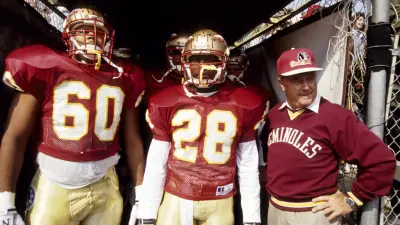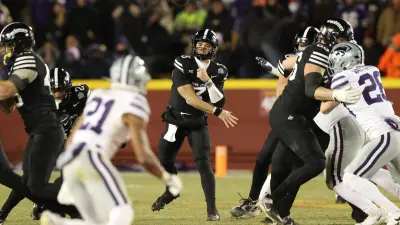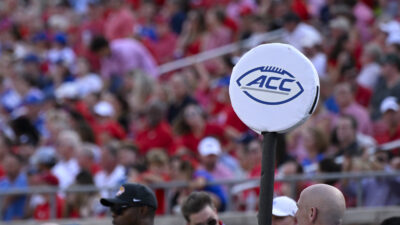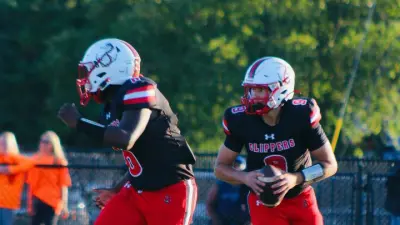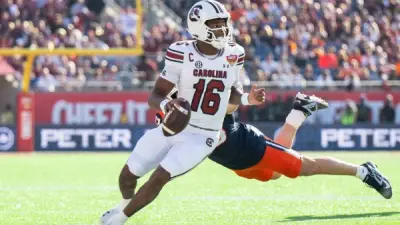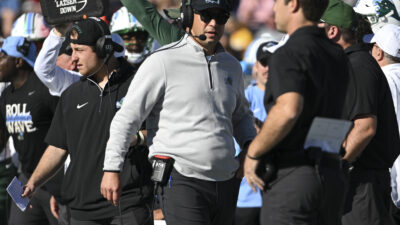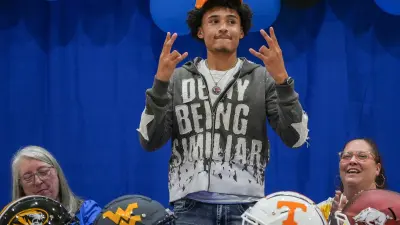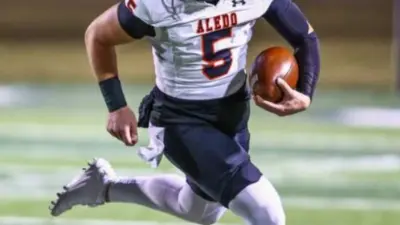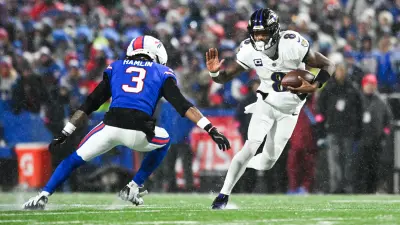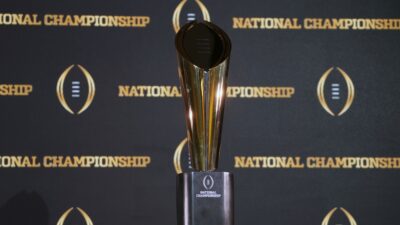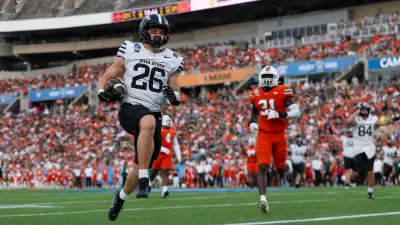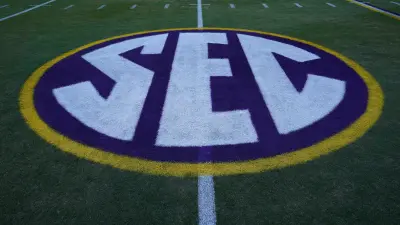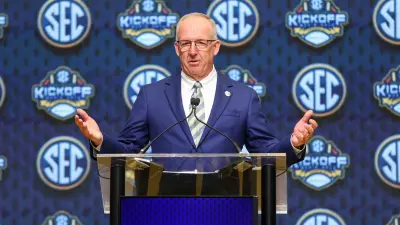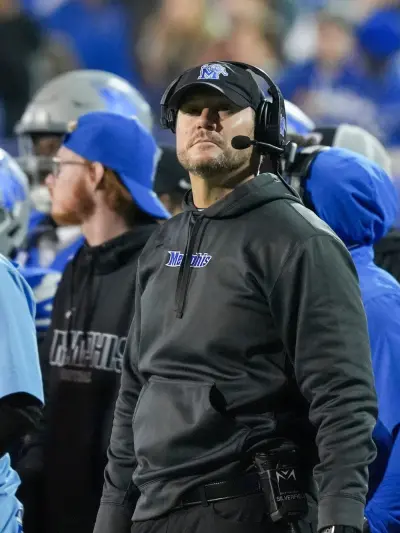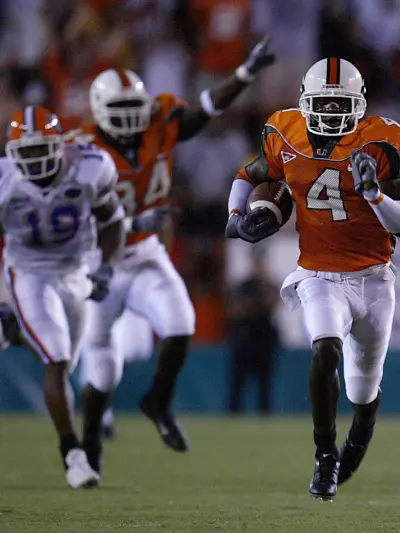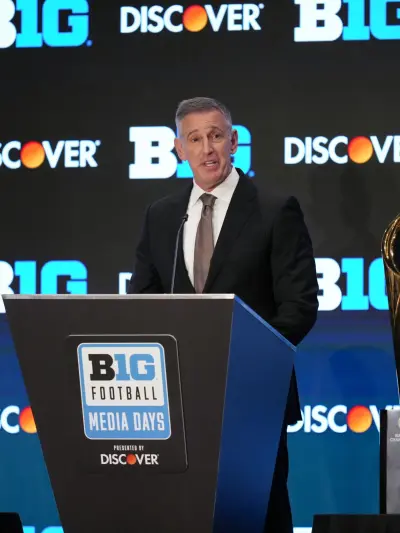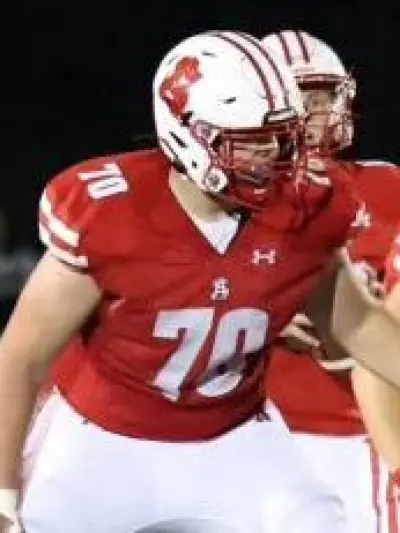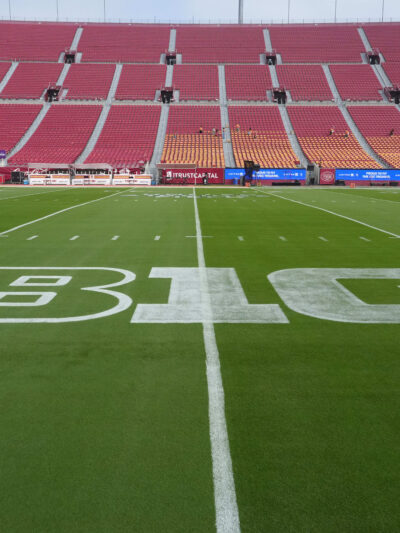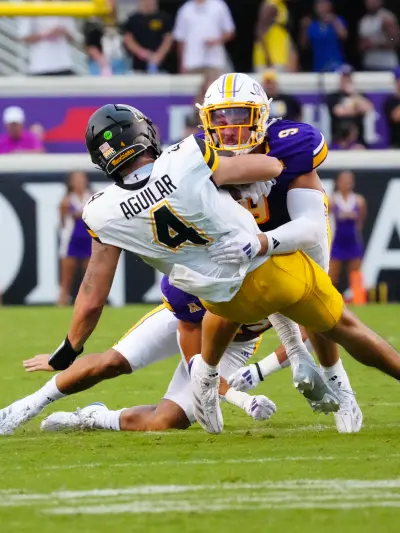Anyone. Anywhere. Anytime.
The mantra Bobby Bowden instilled into his Seminoles as he built the program from a national doormat to a national power.
It was a mantra that his players bought into, believed in, and lived by. Vicariously, the program began to rise faster than most anticipated by reaching back-to-back Orange Bowls in the late 1970s.
The program never rested on its laurels and continued the tradition of “Anyone, Anywhere, Anytime” when FSU played five consecutive road games in 1981 against Notre Dame, Nebraska, Ohio State, LSU, and Pitt. The Seminoles won three of those contests.
The foundation Bowden built began to pay off as he was able to attract elite talent to Tallahassee and began to contend for national championships.
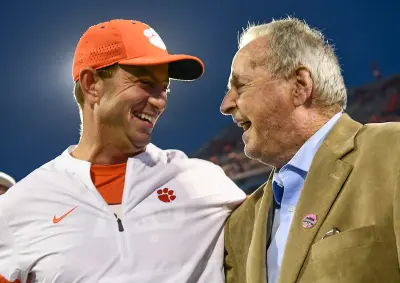
Florida State joined the Atlantic Coast Conference in 1992, ending its time as an independent. At that time, for Bowden, he had Florida State on the precipice of a much-eluded national championship.
More Sports News
Florida State had a pair of 11-1 seasons in 1987 and 1988 that left them just short of the national championship.
Both losses came by way of their top rival and the top program of the 1980s, Miami. In 1987, in one of the greatest regular season games of all time, after the Seminoles scored a late touchdown to close the gap to a point, he chose to go for the win instead of settling for the tie by going for a two-point conversion. Florida State quarterback Danny McManus dropped back to pass only to have his pass deflected by Miami’s Bubba McDowell.
Going into the 1988 season, much of Florida State’s foundation was back for another season, while Miami sent another giant export of talent to the NFL. The pollsters ranked Florida State preseason No. 1, and they took that ranking on the road on opening weekend to the Orange Bowl against No. 6 Miami.
Most felt it would be a titanic battle with CBS using highlights from the previous seasons’ clash in their promotions and hype videos for the game. The game was any but a titanic clash. Miami dominated from the opening whistle to the final gun, and Florida State was left reeling in a 31-0 rout.
As the 1990s began, Bowden entered his silver anniversary as a head coach with two key objectives; figure out Miami, and win the elusive national championship that the program had flirted with the previous three seasons finishing in the Top 4 in the polls.
For many, the game that put Florida State on the map nationally came in 1991, when the top-ranked Seminoles traveled to Ann Arbor to face No. 3 Michigan at The Big House.
The pregame hype consisted of the matchup between Florida State cornerback Terrell Buckley and Michigan’s eventual Heisman Trophy-winning wide receiver Desmond Howard.
Seminole fans did not have to wait long to see who would make an impact, as on the second play from scrimmage, Buckley jumped an Elvis Grbac out-route throw to Howard and intercepted it for a 40-yard pick-six.
It was an ominous feeling for Wolverines fans that this wasn’t going to be their day. Running back Amp Lee had a monster day with 122 yards rushing and two touchdowns that included a highlight 44-yard touchdown run. Quarterback Casey Weldon passed for 268 yards and three touchdowns in a 51-31 win against the Wolverines.
The 51 points Florida State scored were the most points an opponent had scored against Michigan at Michigan Stadium (at the time), and the most points scored against Michigan since Ara Parseghian’s Northwestern Wildcats scored 55 in 1958.
The momentum was riding high for the Seminoles as they were ranked No. 1 in the country.
Bowden then had a collision with his primary nemesis, the Miami Hurricanes, in a very highly anticipated No. 1 vs. No. 2 matchup at Doak Campbell Stadium.
The Hurricanes had taken down two Top 10 ranked opponents in Dave Klingler’s Houston Cougars and against Penn State in their first matchup since the highly anticipated Fiesta Bowl.
As Keith Jackson opened the telecast and the ABC hype video was serenaded by Gary Glitter’s “Rock and Roll Part 2,” the titanic clash between the top two opponents lived up to all that hype and then some.
Miami opened the game with a statement with a 74-yard drive that was capped by a Stephen McGuire two-yard touchdown.
In the second quarter, costly Miami turnovers and miscues gave Florida State the momentum as they pulled again and carried the momentum into the fourth quarter. The Seminoles dominated the stat sheet in the third quarter, outgaining Miami 158 yards to 38 yards and holding the ball for two-thirds of the quarter. However, they weren’t able to convert on a key sequence early in the fourth quarter.
The Seminoles had the ball on the Hurricanes’ four-yard line, and instead of passing, Bowden chose to run. The Seminoles got gobbled up, leading to a third Gerry Thomas field goal to go up 16-7.
Bowden would say after the game why he chose to run on that key point over the pass, “We could have thrown a pass, but I was afraid it would be intercepted or deflected.”
Miami responded and showed life for the first time since the opening drive and stormed back to take a slim 17-16 lead.
With three minutes to go, Florida State responded to the adversity and drove to the Miami 17-yard line, where Bowden elected to kick the potential game-winning field goal on third down.
From 34 yards out, Thomas pushed the kick to the right, and Bowden dropped his 11th game of 16 matchups against Miami up to that point in what will forever be known as “Wide Right I.”
Bowden once said about his hard luck against Miami, “I think the curse is they’re on our schedule. They’re going to chisel on my tombstone, ‘At least he played Miami.'” and the cruelty of that curse was on full display for the 1992 game with Miami at No. 2 and Florida State No. 3.
The game played eerily similar to the 1991 affair, Miami established a lead, and Florida State clawed back and took a slim lead. In an eerily similar process, Florida State had a similar situation where it was third and medium went for a run instead of pass, similar result was a third Dan Mowrey field goal to make it a 16-10 lead for the Seminoles.
Miami responded with a Lamar Thomas touchdown to go up 17-16, a special teams miscue by Florida State in the end zone gave Miami a two-point safety to go up 19-16.
Florida State had one last desperation drive as quarterback Charlie Ward moved the Seminoles into field goal position. The end result felt like another notch on the “Hurricane Curse Post” as Mowery missed the kick to the right as time expired in a game known as “Wide Right II.”
Two weeks later, against Georgia Tech, Bowden, out of necessity, changed his offense. The impact paid huge dividends not only that day, but it made Charlie Ward an eventual Heisman Trophy quarterback.
The Seminoles trailed Georgia Tech 21-7, Bowden decided to position Ward into the shotgun, implement a no-huddle attack that would be dubbed the “Fast Break Offense,” and the rest would be history. The Seminoles rallied back to beat Georgia Tech 29-24.
Before the Georgia Tech game, Ward was criticized for timely miscues and turnover issues and turned into an offensive juggernaut.
The 1993 Seminoles began the season as No. 1 and got off to a 9-0 start, which included four ranked wins and a statement 28-10 win against Miami.
Quarterback Charlie Ward had a Heisman campaign in full momentum and was supported by running back William Floyd, wide receivers Tamarick Vanover and Kez McCorvey, and linebacker Derrick Brooks.
Florida State had a collision against No. 2 Notre Dame at Notre Dame Stadium in a game that would be known as “The Game of The Century.”
If you never saw the opening NBC did for this game, it may be the greatest visual ever done prior to a college football game. The game also has the distinction as the first-ever on-campus visit for the iconic pregame show ESPN’s College Gameday.
The game itself looked early and often to be a one-sided affair for Notre Dame as they climbed to a 31-17 lead into the fourth quarter.
Although Notre Dame led the entire game, the momentum slowly began to swing back to Florida State, as the Seminoles seemed to awaken as the game progressed.
Late in the fourth quarter, Charlie Ward drove Florida State down the length of the field and hit Kev McCorvey on 4th-and-20 for a touchdown with just over 90 seconds to go in the ball game.
The Seminoles then stormed the length of the field to the Fighting Irish 14-yard line. Ward dropped back and rolled out, sending a desperation heave toward the end zone, only to be denied by a Notre Dame defender as time expired.
The loss stung the weary Seminoles, but pollsters felt Florida State simply ran out of time and dropped them to No. 2.
The next weekend No. 1 Notre Dame traveled to Boston College in their annual Holy War rivalry. The Irish were stunned by Tom Coughlin’s Eagles 41-39 as the Irish simply couldn’t hold back BC as they completed a 22-point comeback.
The loss returned Florida State to No. 1 in the country following their win over No. 7 Florida and set up a matchup in the Orange Bowl against No. 2 Nebraska, featuring a dynamic quarterback battle between Heisman Trophy winner Charlie Ward and Nebraska quarterback Tommie Frazier.
The game lived up to the hype, after a slow first half where the Seminoles and Huskers dueled like two heavyweight prized fighters, the second half became explosive.
In the third quarter, Florida State’s running back William Floyd scored a controversial touchdown where on the replay, Floyd looked like he fumbled, but the officials ruled it a touchdown.
At the start of the fourth quarter, Lawrence Phillips inched Nebraska back on a 12-yard touchdown to make it 15-13. Nebraska attempted a two-point conversion to try to tie it at 15 but was denied.
Late in the fourth quarter, Nebraska drove to the FSU 10-yard line before stalling and hitting a 27-yard field goal with 1:16 remaining to take a 16–15 lead.
Aided by a special teams miscue by Nebraska where the kickoff went out of bounds, FSU took over with excellent field position, Charlie Ward was able to drive the Seminoles all the way to the Nebraska 3-yard line.
The Blackshirt defense held, forcing a short FSU field goal attempt that was good to give the Seminoles an 18–16 with just 21 seconds remaining.
Florida State had their near-fatal miscue following the made field goal when Florida State sideline went into excessive euphoria in their celebrations and was subsequently penalized for excessive celebration, costing them 15 yards on the ensuing kickoff.
Nebraska capitalized on the miscue and got to the Nebraska 43-yard line.
As the final seconds ticked away, Frazier hit tight end Trumane Bell for a 29-yard gain to the FSU 28-yard line.
The clock seemingly expired, setting off more chaos on the FSU sideline.
The officials huddled and ruled that Bell was down with one second left on the clock, and ordered the field cleared, allowing Nebraska one last chance to win the game.
As Nebraska’s attempt sailed wide left, the euphoria of becoming national champion sat in for Bowden.
Bowden, who had always demonstrated grace in his tough defeats, knew that his counterpart Osborne was feeling, said after the win, “Nebraska played as good or better than us.”
During the 1990s, Bowden saw a transition in primary rivals. Throughout the 1980s, Miami was the predominant football program in the country. Into the 1990s, Florida State continued to get bit by Miami with the “Wide Right” clashes. The Hurricanes had self-inflicted administrative issues that included Pell Grant fraud Miami wasn’t able to recover until the early 2000s against Florida State.
The Seminoles though had another in-state rival emerging as a national championship threat in Steve Spurrier’s Florida Gators.
Arguably the sweetest “win” Bowden had against Spurrier wasn’t a win at all.
The 1994 encounter would have extra flair as Spurrier would jab the Seminoles for the Foot Locker shoe scandal that rocked the program, calling them “Free Shoes University.”
The Gators silenced the crowd at Doak Campbell Stadium, storming to a 31-3 lead, and most thought the Fun ‘N Gun would pour in on the fourth quarter.
That wasn’t the case, as Spurrier went conservative by running Fred Taylor repeatedly and going to prevent defenses.
Bowden took what Spurrier was offering, and in his high-tempo offense, the Seminoles scored 28 points in the final stanza to force a 31-all tie.
The game would forever be known as the “Choke at Doak,” and bowl alliances created a Florida vs. Florida State game at the Sugar Bowl that would be promoted as “The Fifth Quarter In The French Quarter.”
In the contest, Warrick Dunn had 182 all-purpose yards that, included a 73-yard touchdown pass to Omar Ellison. The Seminoles took the rubber match 23-17.
One of the few times Florida State played spoiler in their highly contested matchups came in the 1996 regular-season finale at Doak Campbell Stadium, a game Bowden considered the best home win in his career.
Florida was No. 1, and Florida State was No. 2, and the Seminoles capitalized on three early interceptions by Florida quarterback Danny Wuerffel to take a 17-0 lead.
Florida clawed back in the contest behind Wuerffel’s 362 yards through the air. However, it was a Florida State defense that sacked Wuerffel six times and Dunn had 185 yards rushing and the Seminoles spoiled the Gators’ attempt at a perfect season 24-21.
In the 1990s Bowden had 12 Top 10 matchups against Florida and had a record 7-4-1 in those contests.
The conclusion of the decade saw Bowden’s coaching opus as the 1999 Florida State Seminoles became the first time to go wire-to-wire as the No. 1 team in the country.
Florida State was composed of quarterback Chris Weinke, dangerous wide receivers Peter Warrick, Lavernous Coles, Marvin “Snoop” Minnis, defensive lineman Corey Simon, and kicker Sebastian Janikowski.
The season was highlighted by a titanic clash at Florida where they were ranked No. 3. Peter Warrick had a touchdown and set up the deciding score for Florida State to win 30-23.
“Every time Florida and Florida State play, it puts someone in the national championship game,” Bowden said after his Seminoles completed their third perfect regular season. “We’re just happy we’re there.”
The matchup set up a national championship appearance against an upstart Virginia Tech program that had gone undefeated in the Big East with generational quarterback Michael Vick.
Vick had Virginia Tech in position for the upset, starting the fourth quarter up 29-28 and the Hokies would eventually outgain Florida State 503 to 359. The game will forever be remembered by the Herculean effort by wide receiver Peter Warrick.
Warrick would account for 20 of Florida State’s 46 points and have 220 all-purpose yards (163 receiving and 57 return yards) and three total touchdowns (2 receiving and 1 punt return).
As I conclude this series on coaches of the 1990s, it was agonizing at first to debate who was the better coach between Tom Osborne and Bobby Bowden.
On the surface it is classic sports debate: do you covet the amazing peak of Osborne going 60-3 in his final five seasons with three national championships or do you covet the consistency Bowden had being in the Top 5 every year of the decade?
Both coaches had amazing feats in the decade, the 1995 Nebraska team is considered by many the greatest team ever and the 1999 Florida State team was the first team to go wire-to-wire ranked No. 1.
The surface tells you to pick Osborne. When you consider additional factors is where Bowden begins to run away with this.
Bowden coached and won more games than Osborne in the decade 109 to 87, but to even things a bit Bowden had the slight edge in winning percentage at 89% to 88.3% for Osborne.
While both coaches played for four national championships, Osborne has the slight edge in national championships (3 to 2), Bowden won more conference championships (8 to 6), Top 5 finishes (10 to 5), and won more bowl games (8 to 4).
The gap begins to widen in my mind when you consider their records against Top 10 opponents. Bowden coached in 12 more games than Osborne (30 to 18) against Top 10 teams, had a higher winning percentage (65% to 61%), and won more games (19 to 11).
Also, while Colorado had a brief time at the beginning of the decade as a national power, Florida State had to contend with on an annual basis Florida and Miami on their schedules, and for the first half of the 1990’s both were Top 5 programs.
A final metric to consider, if you were to include the 1990 Fiesta Bowl that Nebraska and Florida State played in (game played January 1, 1990, but for the 1989 season), Florida State was 3-0 against Nebraska head-to-head in games played in the 1990s. It’s hard to ignore.
Nebraska may have had a much higher peak under Osborne, but it was Florida State that went wire to wire in the 1990s defining the decade and being involved in the decade’s most memorable games (Bowden coached Florida State in 11 Top 3 matchups). Given as well the aforementioned differences between Bowden and Osborne, I give Bowden the edge and him as the No. 1 coach of the 1990s.
